To celebrate our 75th Jubilee (in 2022), we added a new mineral image to the Images of Clay archive for each month of the year.
All 12 of the new images were from Great Britain and Ireland. In addition to adding these new images, the CMG would like to solicit additional images for the archive from clay mineralogists around the world. Please see the website for how to do this.
January 2022 – Scottish halloysite
This is a halloysite, which remarkably was first described in 1880 by Heddle (Min. Mag. 5, 22, p1-2). It comes from Hospital Quarry, near Elgin, Scotland. This is a sandstone quarry (Rosebrae beds of the Upper Old Red Sandstone) and was reportedly used to build both Elgin Cathedral and Dr Gray’s Hospital, Elgin, hence Hospital Quarry. Heddle reports a chemical analysis of the material. The image is of a specimen from the Macaulay Collection at the James Hutton Institute in Aberdeen. A counterpart of the same specimen (493-1) is held by the National Museum of Scotland (NMS) as part of the Heddle collection, the 1 indicating it was the first halloysite specimen registered at the NMS. The specimen is an off-white powder and appears to be a clay size fraction separated to concentrate the clay, by Heddle?! More recent investigations have shown that the halloysite is a prismatic/polygonal form and occurs in association with gorceixite (a barium phosphate of the plumbogummite group), goethite and quartz. It seems astonishing how this clay was correctly identified as halloysite in 1880, presumably based on its chemical analysis, and perhaps counts as one of the earliest adventures into the realms of clay mineralogy. This image has now been added to the ‘Images of Clay’ archive. What will next month’s image be!
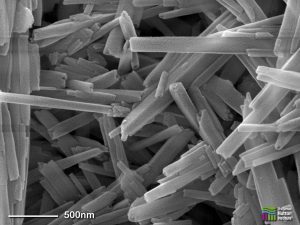
Caption: Halloysite from Hospital Quarry, Elgin, Scotland, first described in 1880 by Heddle (Min. Mag. 5, 22, p1-2). Field of view ≈3 µm wide. Photo courtesy Evelyne Delbos.
February 2022 – Yorkshire berthierine
February’s image comes from a sample of oolitic iron stone from the Jurassic rocks of Cornelian Bay, Scarborough, Yorkshire, England. The Jurassic ironstones in Yorkshire were mined from Roman times right through to the 1960’s as a source of iron ore. Analysis of the mottled bottle green and red hand specimen by X-ray diffraction indicates that it consists mainly of siderite and berthierine along with minor quartz. The berthierine occurs as ooids and in detail is interstratified with chamosite (chlorite). There is also a minor micaceous component admixed through the rock. The image is from near the outer edge of an ooid of approximately 0.7 mm diameter showing the compact clay rich lenticular fabric. The platy berthierine lacks any obvious euhedral form, perhaps because of the low porosity.
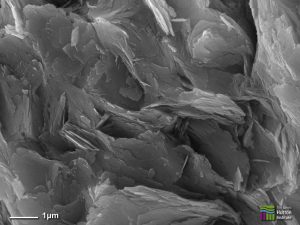
Caption: This is the 2022 CMG 75th year Jubilee clay for February. Berthierine in the interior of an ooid from a sample of a Jurassic ironstone, Cornelian Bay, Scarborough, Yorkshire, England. The berthierine was confirmed by XRD and shows evidence of interstratification with chlorite. Field of view ≈ 10.5 µm wide. Photo courtesy Evelyne Delbos.
March 2022 – Cornish kaolinite
March’s image is of kaolinite books and plates from Cornwall. The image was taken from a sample of the unprocessed kaolinitised granite, collected in Littlejohns pit, near St Austell, England. So called ‘China clay’ was first discovered in this region in the mid 1700’s. Since then, an estimated £15 billion worth of clay has been extracted. The Littlejohns pit is part of one of the largest China clay pits in the world. Sample courtesy Imerys, Frank Hart and Ian Wilson.
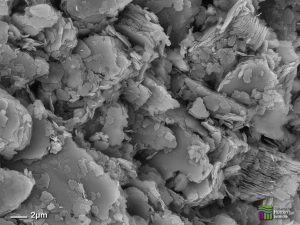
Caption: This is the 2022 CMG 75th Jubilee clay for March. Kaolinite books and plates from Cornwall. The image was taken from a sample of the unprocessed kaolinitised granite, collected in Littlejohns pit, near St Austell, England. So called ‘China clay’ was first discovered in this region in the mid 1700’s. Since then, an estimated £15 billion worth of clay has been extracted. The Littlejohns pit is part of one of the largest China clay pits in the world. Sample courtesy Imerys, Frank Hart and Ian Wilson. Field view ≈36 µm wide. Photo courtesy Evelyne Delbos.
April 2022 – Irish gibbsite
April’s image is of gibbsite crystals from the Tertiary inter-basaltic laterite horizon in Northern Ireland. This sample comes from Clinty quarry in Country Antrim. The inter-basaltic laterite horizon in Northern Island, which is spectacularly exposed near the Giant’s Causeway, represents a prolonged period of quiescence between the eruption of the lavas, allowing deep and extensively lateritic weathering under the tropical? climate of the Eocene in this region. The sample examined contains over 40% alumina, and the original basalt has been altered to a mixture of gibbsite, halloysite, and various iron and titanium oxides.
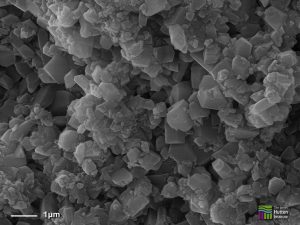
Caption: Euhedral crystals of gibbsite from the Tertiary inter-basaltic laterite horizon in Northern Ireland. This sample comes from Clinty quarry in Country Antrim. Field of view ≈ 11.5 µm wide. Sample collected by Steve Hillier, photo taken by Evelyne Delbos.
May 2022 –Welsh dickite
This is an example of the kaolinite-serpentine group mineral dickite. However, this is not just any dickite, but a specimen from the type locality for dickite at Pant-y-Gaseg Mine, Trwyn-Bychan, Anglesey, in Wales, where it occurs in association with quartz veins cutting through a ‘blue slate’. It was first described (then as kaolinite) by (Allan) Dick in a paper read to the Mineralogical Society of Great Britain and Ireland in January 1888, and, of course, the mineral is now named after him. Working mainly with a petrological microscope, Dick describes the forms of many of the larger crystals, which were separated by a sedimentation procedure, and his amazingly detailed figures show the (spiralled) growth steps on the platy forms.
Dick, Allan (1888) On Kaolinite. Mineralogical Magazine and Journal of the Mineralogical Society, 8 (36) 15-27 doi:10.1180/minmag.1888.008.36.03
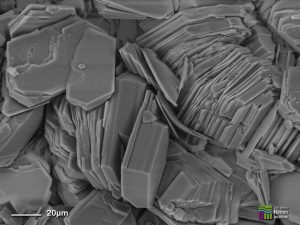
Caption: Well-formed dickite crystals from the type locality for dickite at Pant-y-Gaseg Mine, Trwyn-Bychan, Anglesey, in Wales, where it occurs in association with quartz veins cutting through a ‘blue slate’. Field of view is ≈ 200 µm. Photo courtesy Evelyne Delbos.
June 2022 –Scottish saponite
This is an example of the trioctahedral smectite known as saponite from the isle of Skye, Scotland. Saponite is a common occurrence in vesicles and veins associated with the Tertiary lavas on Skye. This example is magnesium-rich and its interlayer cations appear to be mainly calcium. The SEM images reveal that the clay occurs as large fans and rosettes up to 100 µm in diameter! A similar example was described in 1957 by Robert Mackenzie (doi:10.1180/minmag.1957.31.239.05) one of the founders of the Clay Minerals Group.
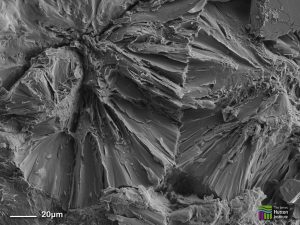
Caption: Saponite formed as large fans and rosettes up to 100 µm in diameter from a vein in Tertiary lavas from the Isle of Skye, Scotland. Field of view ≈170 µm wide. Photo courtesy Laura-Jane Strachan and Evelyne Delbos.
July 2022 – Irish Kaolinite/smectite
July’s clay is an interesting example of a rare (are they really?) interstratified kaolinite/expandable clay. It comes from near Cloyne, County Cork, Ireland. The clay, which is unfortunately no longer accessible, was worked and sold as Irish ‘Bond Clay’ for use in foundry moulds. Palynological evidence indicates a Middle Jurassic age for the clay which occurs in a karstic depression in Carboniferous limestone. Originally described by as a disordered kaolinite in some early publications, it was identified as an interstratified kaolinite/smectite by Doff (1991) in a paper read at the CMG Spring Meeting held at Trinity College, Dublin that year, and subsequently described in some detail by Hughes et al., (1993, https://doi.org/10.1346/CMS-SP-1), wherein it is referred to as the ‘Doff’ sample. The interstratification appears to be partially ordered with ≈ 20% smectite/80% kaolinite. The SEM images shows the typical wavy texture of large clay domains that appear to be profusely segmented into much smaller pseudo hexagonal plates; perhaps reflecting an origin by weathering of a smectite precursor via a mechanism involving nucleation of kaolinite on and within the parent expandable clay?
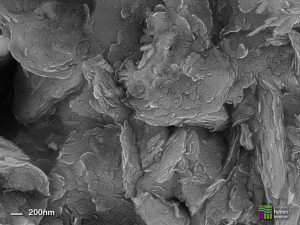
Caption: Kaolinite/smectite from Cloyne, County Cork. The clay is Middle Jurassic age and was worked and sold as Irish Bond Clay. It is described in some detail by Hughes et al., (1993, https://doi.org/10.1346/CMS-SP-1), wherein it is referred to as the ‘Doff’ sample. The SEM images shows the typical wavy texture of large clay domains that appear to be profusely segmented into much smaller pseudo hexagonal plates. FOV ≈ 5 µm. Image courtesy Evelyne Delbos and Laura-Jane Strachan.
August 2022 – Devonian palygorskite
This is is palygorskite from near the town of Seaton in the county of Devon, southwest England. Palygorskite in the form of long bundles of fibres several micrometres or more in length, with individual fibres some fraction of a micrometre in diameter occur widely at Berry and Branscombe West Cliffs. The example shown is from a tensional joint filling in the reddish/brown Mercia Mudstone (formerly Keuper Marl) and occurs commonly in association with calcite and celestite over an interval of 8 metres. Palygorskite also occurs in the mudstone matrix of this sequence, associated with dolomitic and gypsum nodules ….the distribution is shown in figure 41, p. 575 of Jeans 1978 (https://doi.org/10.1098/rsta.1978.0068) . The general coincidence between the distribution of palygorskite in the tensional veins and mudstone matrix suggests the sediment was stewing in a potentially palygorskite-celestite-calcite precipitating pore fluid and the opening of the tensional cracks allowed the rapid precipitation from a pore solution highly oversaturated in regard to the three phases.
.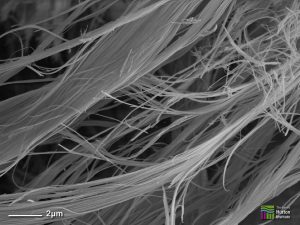
Caption: Bundles of long palygorskite fibres from a tension joint in the Mercia Mudstone, Berry and Branscombe West Cliffs, near Seaton, Devon, England. Field of view ≈ 13.5 µm. Photo courtesy Evelyne Delbos and Laura-Jane Strachan.
September 2022 –Worcestershire illite/smectite
An illite/smectite (I/S) interstratified clay mineral. This example is from a Silurian (Ludlow) K-bentonite from Woodbury Quarry, Worcestershire. X-ray diffraction patterns of the sample show it to consists of an R1 ordered I/S with around 25% expandable (smectite) layers. The SEM image of a fractured surface reveals the platy nature of the clay particles that seem to be composed of assemblies of still smaller plates. This sample was first studied in some detail by a former chairman of the CMG and editor of Clay Minerals, Dr David Morgan (as part of his PhD), and subsequent studies were conducted on it together with some other well know clay mineralogists! For example, see sample ‘M5’ in the paper on the ‘Chemistry of Illite/Smectite and End-Member Illite’ in Clays Clay Miner. 34, 368–378 (1986). https://doi.org/10.1346/CCMN.1986.0340403 and ‘Stratigraphy, mineralogy and tectonic setting of Silurian K-bentonites in southern England and Wales’ in the Proceedings of the 9th International Clay Conference, Strasbourg, France https://www.persee.fr/doc/sgeol_0302-2684_1990_act_88_1_2167
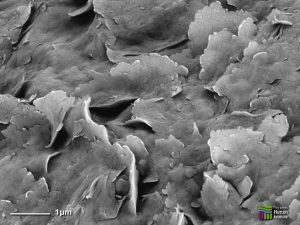
Caption: This is an R1 ordered Illite(75)/smectite(25) from a Silurian K-bentonite Woodbury Quarry, Worcestershire. The image, of a freshly fractured surface of a piece of the bentonite, shows the platy nature of the clay particles that seem to be composed of assemblies of still smaller plates. The sample is ‘M5’ in the paper ‘Chemistry of Illite/Smectite and End-Member Illite’. https://doi.org/10.1346/CCMN.1986.0340403. Field of view ≈ 7.5 µm, image courtesy Laura-Jane Strachan.
October 2022 – Cornish allophane
This is allophane from Hawks Wood (Tungsten) mine, Bodmin Moor, Cornwall. The allophane was confirmed by infrared spectroscopy, whilst EDS analysis in the SEM indicates major aluminium and silicon, but also significant phosphorous, perhaps suggesting admixture with evansite? By X-ray diffraction, the sample is confirmed as amorphous. The images show the fine botryoidal habit of the mineral which occurs coating surfaces of the granitic rocks in the mine in the form of ‘flowstone’, presumably indicating its fairly recent formation from percolating waters. October’s image is allophane from Hawks Wood (Tungsten) mine, Bodmin Moor, Cornwall. The allophane was confirmed by infrared spectroscopy, whilst EDS analysis in the SEM indicates major aluminium and silicon, but also significant phosphorous, perhaps suggesting admixture with evansite? By X-ray diffraction, the sample is confirmed as amorphous. The images show the fine botryoidal habit of the mineral which occurs coating surfaces of the granitic rocks in the mine in the form of ‘flowstone’, presumably indicating its fairly recent formation from percolating waters.
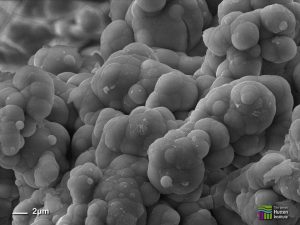
Caption: Microbotryoidal allophane, from a flowstone deposit, Hawks Wood mine, Bodmin Moor, Cornwall, a former tungsten mine at the edge of the Bodmin Moor granite. Field of view ≈ 40 µm. Image taken by Laura-Jane Strachan.
November 2022 – Kent Ca-montmorillonite
According to Robertson (1986), evidence for the use of clays as fuller’s earth has been found in neolithic sites in Cyprus (5000 BC) and for many centuries fuller’s earths from the county of Kent were the main English source of this valuable commodity. The mineral in this example, imaged on a freshy fractured surface of a piece of fuller’s earth from the Cretaceous Sandgate Formation, near Ightham, Kent, is a calcium montmorillonite. According to Jeans (2006), the fuller’s earths (bentonites) in the Sandgate Formation were derived from the alteration of volcanic ash of trachytic composition.
Robertson R.S.H (1986) Fuller’s earth. A history: Pp. 421. Volturna Press, Hythe. Jeans, C. (2006). Clay mineralogy of the Cretaceous strata of the British Isles. Clay Minerals, 41(1), 47-150. doi: 10.1180/0009855064110196
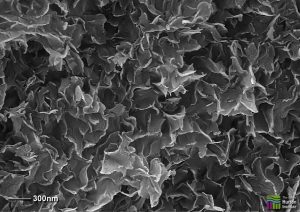
Caption: Ca-montmorillonite from a sample of fuller’s earth from the Cretaceous Sandgate Formation, near Ightham, Kent. Field of view is approx. 3.8 µm wide. Image courtesy Laura-Jane Strachan.
December 2022 – Hampshire glauconite
This is December’s clay mineral image, the last in the series of 12 images of clay minerals, all from the UK and Ireland added to the ‘Images of Clay’ archive as part of the Clay Minerals Group 75th Jubilee year celebrations shows swirling plates of glauconite from the (fractured) interior of a glaucony pellet from the Eocene age, Wittering Formation, Hampshire Basin, Isle of White, England. The characteristic and occurrence of glaucony grains from this area were described in detail by Huggett and Gale (1997) doi: 10.1144/gsjgs.154.5.0897
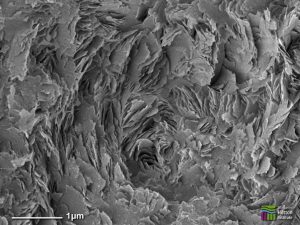
Caption: Swirling plates of glauconite from the (fractured) interior of a glaucony pellet from the Eocene age, Wittering Formation, Hampshire Basin, Isle of White, England. Field of view ≈ 6 µm wide, image courtesy Evelyne Delbos, James Hutton Institute.
Winning image!
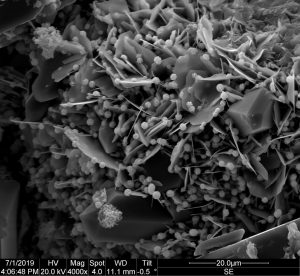
This is the winning image submitted for the CMG’s 75th Jubilee year competition. It shows small clusters of goethite crystals, many showing star-like multidomain twins, sitting on platy crystals of chlorite from the Triassic Schleerieth Sandstone, Germany. Presumably, the buff colour of this sandstone, which has been widely used as building stone, reflects the presence of goethite. Field of view ≈ 75 µm.
The image was submitted by Marli de Jongh, BGS.
